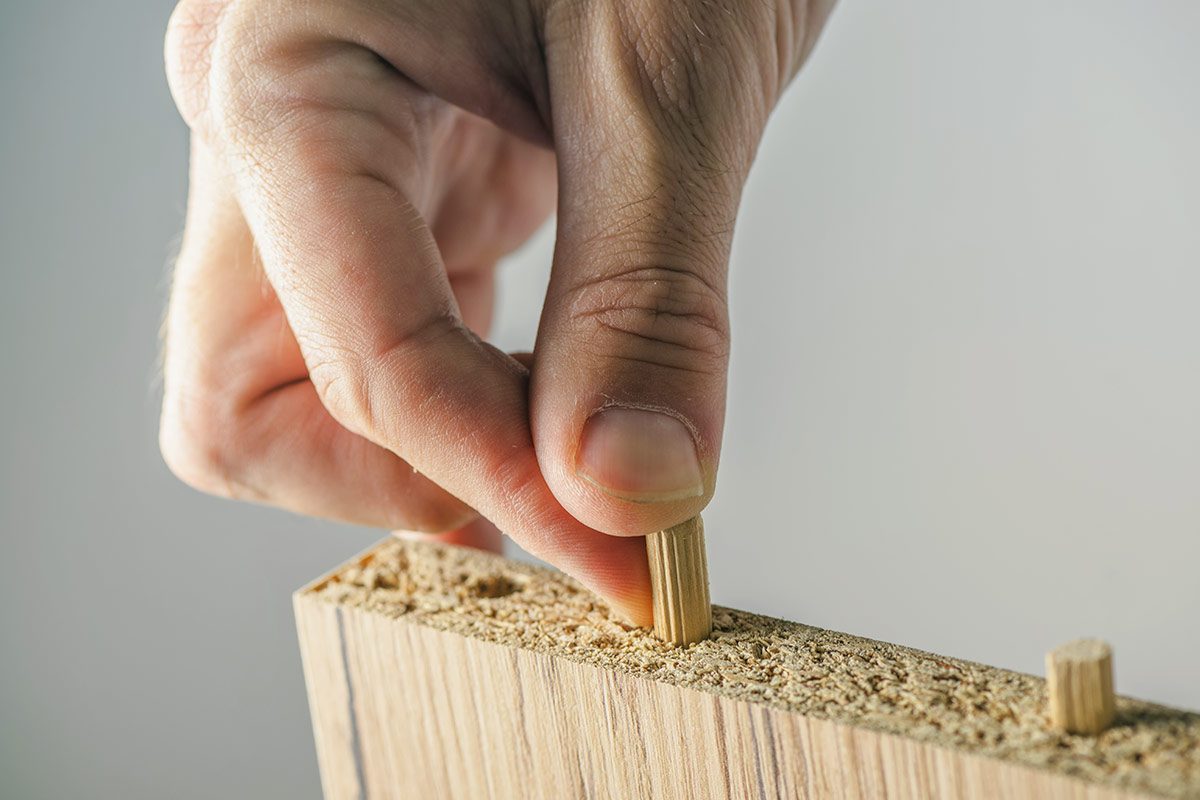Dowel joints are important in woodworking and furniture making because they offer a combination of strength, precision, and ease of use. Here’s a breakdown of why they matter so much:
-
Strength:
Dowels provide strong mechanical resistance. When inserted into aligned holes in two pieces of wood, they act like tiny hidden pegs that reinforce the joint, distributing stress across a larger surface area. This makes the connection much stronger than simple glued butt joints. -
Alignment:
Dowels help precisely align two pieces of material during assembly. Because they fit snugly into pre-drilled holes, they prevent slipping or misalignment, leading to cleaner, more professional-looking work. -
Hidden Joinery:
Unlike screws or nails, dowels are hidden inside the wood, leaving no visible fasteners. This is ideal for furniture or decorative pieces where aesthetics are important. -
Even Glue Distribution:
The holes for the dowels create more surface area for glue to bond, and the dowels themselves soak up glue, which strengthens the joint internally without needing clamps for long periods. -
Speed and Efficiency:
Once you have a doweling jig or doweling machine, creating dowel joints can be faster than more complex joints like mortise and tenon, while still offering impressive strength. -
Versatility:
Dowels work in edge-to-edge, edge-to-face, and even mitered joints, so they’re useful across a wide range of projects — from tabletops to cabinets to chairs.
In short, dowel joints combine strength, accuracy, appearance, and speed, making them a go-to method for both professional woodworkers and hobbyists.
How Dowels Are Made?
Dowels — those smooth, cylindrical rods used in woodworking — can be made through several methods depending on whether you’re making them by hand, in a small workshop, or industrial-scale. Here’s a breakdown:
1. Handmade Dowels (Traditional Way)
Before machines, woodworkers made dowels by:
-
Whittling a stick roughly round using a knife or drawknife.
-
Driving the stick through a metal plate with different-sized holes (called a dowel plate) to shave it perfectly round.
-
Sanding the dowel smooth after shaping.
This method is still popular among hand tool woodworkers who want authentic, perfectly fitting dowels.
2. Workshop/Small-Scale Production
In a typical woodworking shop:
-
A square blank of wood (slightly bigger than the dowel size) is prepared.
-
It’s then either:
-
Turned on a lathe using a roughing gouge to form a cylinder.
-
Sent through a dowel-making jig attached to a drill or router, which spins the blank and forces it through a cutting head that rounds it off.
-
-
Sand and cut to length afterward.
This is a good method if you need a lot of dowels but want to use specialty woods.
3. Industrial/Factory Production
In factories:
-
Long strips of wood are machine-fed into a rotary cutter or moulder.
-
The machine rounds off the wood rapidly and accurately into perfectly smooth dowel rods.
-
The dowels are then cut to size automatically.
-
Sometimes they are spiral-grooved or ribbed to hold glue better.
-
Finally, they might be kiln-dried to ensure moisture stability.
Industrially made dowels are super consistent, which is why store-bought dowels are so precise in diameter.
Materials for Dowels
-
Hardwoods like birch, oak, maple, and beech are common because they’re strong and resist splitting.
-
Softwoods like pine can also be used, but they’re weaker and mainly for light-duty applications.
Are Dowels Always Made of Wood
No, dowels are not always made of wood — although wooden dowels are the most common, especially in woodworking. Dowels can also be made from plastic, metal, or even composite materials, depending on the application. Here’s a quick overview:
1. Wooden Dowels
-
Most common in furniture, cabinetry, crafts, and joinery.
-
Usually made from hardwoods (like birch, beech, maple) for strength.
-
Used because they expand slightly with glue, locking joints tightly.
2. Plastic Dowels
-
Often used in wall anchors (like drywall anchors) or light-duty mechanical applications.
-
Typically made from nylon, polypropylene, or polyethylene.
-
They flex and resist moisture better than wood, but they aren’t as strong structurally.
3. Metal Dowels
-
Used in heavy engineering, machinery, and precision alignment (think automotive, aerospace, and metalworking).
-
Made from stainless steel, aluminum, brass, or hardened steel.
-
Examples include dowel pins, which precisely align machine parts because of their tight tolerances.
4. Composite or Fiberglass Dowels
-
Used in construction, like rebar replacement in concrete to prevent corrosion.
-
Lightweight, rustproof, and highly durable in harsh environments.
Summary
-
Wooden dowels = Traditional woodworking and furniture making.
-
Plastic dowels = Anchoring lightweight fixtures.
-
Metal dowels = Precision alignment in machines and tools.
-
Composite dowels = Specialized structural work.
Shop Dowel Drawers with DCDrawers.com
Thank you for reading Advantages And Disadvantages Of Dowel Joints. Stay tuned for more from the expert drawer box manufacturers at DCDRAWERS.COM. Shop Dowel Drawers online.







